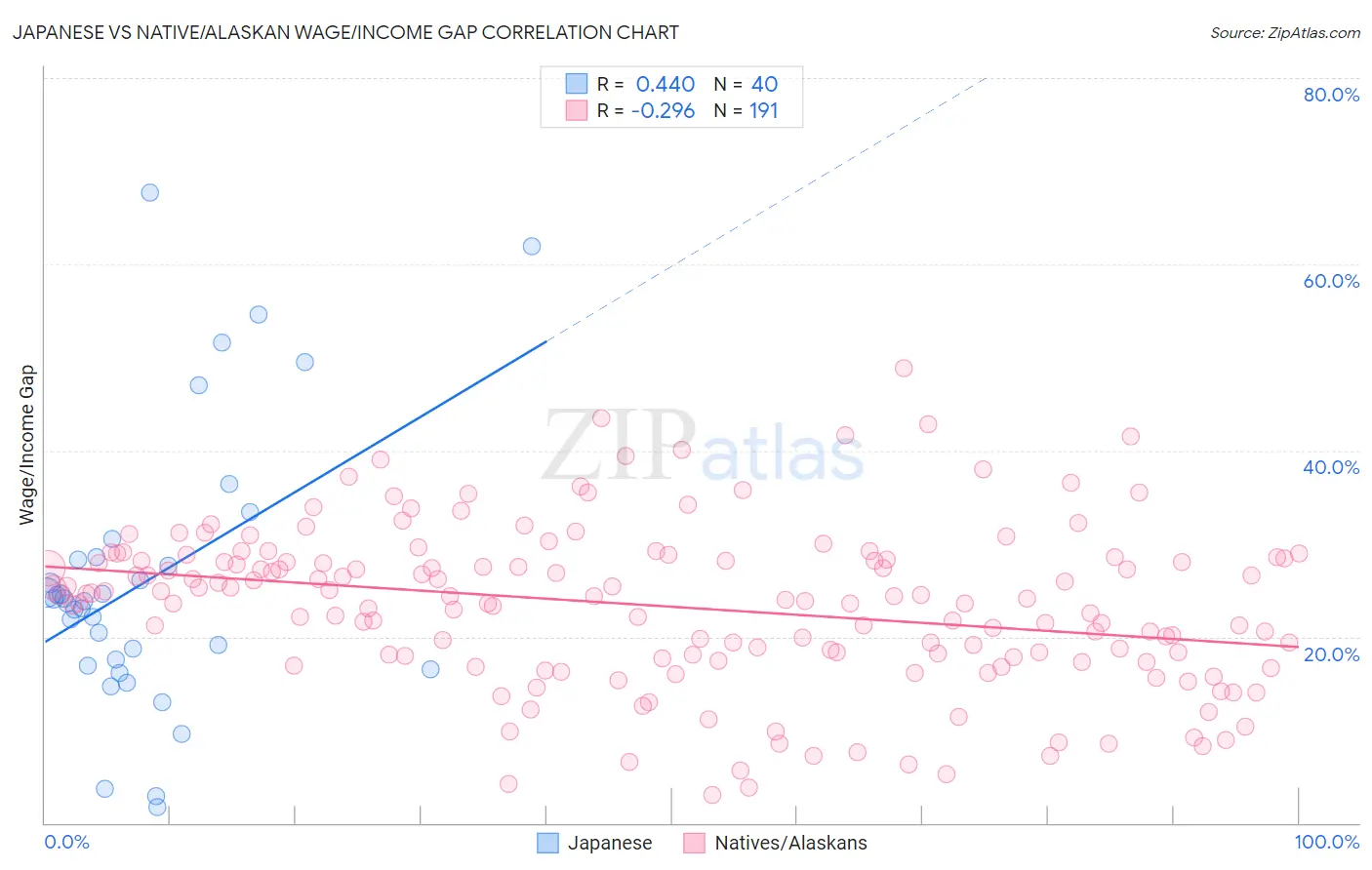Japanese vs Native/Alaskan Wage/Income Gap
COMPARE
Japanese
Native/Alaskan
Wage/Income Gap
Wage/Income Gap Comparison
Japanese
Natives/Alaskans
23.8%
WAGE/INCOME GAP
99.1/ 100
METRIC RATING
101st/ 347
METRIC RANK
24.6%
WAGE/INCOME GAP
94.6/ 100
METRIC RATING
123rd/ 347
METRIC RANK
Japanese vs Native/Alaskan Wage/Income Gap Correlation Chart
The statistical analysis conducted on geographies consisting of 249,130,971 people shows a moderate positive correlation between the proportion of Japanese and wage/income gap percentage in the United States with a correlation coefficient (R) of 0.440 and weighted average of 23.8%. Similarly, the statistical analysis conducted on geographies consisting of 511,624,473 people shows a weak negative correlation between the proportion of Natives/Alaskans and wage/income gap percentage in the United States with a correlation coefficient (R) of -0.296 and weighted average of 24.6%, a difference of 3.3%.

Wage/Income Gap Correlation Summary
| Measurement | Japanese | Native/Alaskan |
| Minimum | 1.7% | 3.1% |
| Maximum | 67.8% | 48.8% |
| Range | 66.0% | 45.7% |
| Mean | 26.0% | 23.3% |
| Median | 23.9% | 24.4% |
| Interquartile 25% (IQ1) | 17.2% | 17.8% |
| Interquartile 75% (IQ3) | 28.4% | 28.4% |
| Interquartile Range (IQR) | 11.2% | 10.6% |
| Standard Deviation (Sample) | 14.8% | 8.6% |
| Standard Deviation (Population) | 14.6% | 8.6% |
Similar Demographics by Wage/Income Gap
Demographics Similar to Japanese by Wage/Income Gap
In terms of wage/income gap, the demographic groups most similar to Japanese are Immigrants from Laos (23.8%, a difference of 0.14%), Yakama (23.7%, a difference of 0.15%), Aleut (23.7%, a difference of 0.17%), Immigrants from Latin America (23.7%, a difference of 0.25%), and Tsimshian (23.9%, a difference of 0.37%).
| Demographics | Rating | Rank | Wage/Income Gap |
| Hondurans | 99.5 /100 | #94 | Exceptional 23.6% |
| Cape Verdeans | 99.4 /100 | #95 | Exceptional 23.6% |
| Kiowa | 99.4 /100 | #96 | Exceptional 23.6% |
| Immigrants | Sudan | 99.4 /100 | #97 | Exceptional 23.6% |
| Immigrants | Latin America | 99.2 /100 | #98 | Exceptional 23.7% |
| Aleuts | 99.2 /100 | #99 | Exceptional 23.7% |
| Yakama | 99.2 /100 | #100 | Exceptional 23.7% |
| Japanese | 99.1 /100 | #101 | Exceptional 23.8% |
| Immigrants | Laos | 99.0 /100 | #102 | Exceptional 23.8% |
| Tsimshian | 98.9 /100 | #103 | Exceptional 23.9% |
| Tlingit-Haida | 98.7 /100 | #104 | Exceptional 24.0% |
| Moroccans | 98.6 /100 | #105 | Exceptional 24.0% |
| Sudanese | 98.6 /100 | #106 | Exceptional 24.0% |
| Yaqui | 98.4 /100 | #107 | Exceptional 24.0% |
| Immigrants | Albania | 98.4 /100 | #108 | Exceptional 24.0% |
Demographics Similar to Natives/Alaskans by Wage/Income Gap
In terms of wage/income gap, the demographic groups most similar to Natives/Alaskans are Apache (24.5%, a difference of 0.070%), Immigrants from Thailand (24.5%, a difference of 0.12%), Immigrants from South America (24.6%, a difference of 0.21%), Spanish American (24.6%, a difference of 0.23%), and Immigrants from Uruguay (24.6%, a difference of 0.25%).
| Demographics | Rating | Rank | Wage/Income Gap |
| Alaska Natives | 96.0 /100 | #116 | Exceptional 24.4% |
| Immigrants | Afghanistan | 95.9 /100 | #117 | Exceptional 24.4% |
| Immigrants | Micronesia | 95.8 /100 | #118 | Exceptional 24.4% |
| Kenyans | 95.8 /100 | #119 | Exceptional 24.5% |
| Cree | 95.6 /100 | #120 | Exceptional 24.5% |
| Immigrants | Thailand | 94.9 /100 | #121 | Exceptional 24.5% |
| Apache | 94.8 /100 | #122 | Exceptional 24.5% |
| Natives/Alaskans | 94.6 /100 | #123 | Exceptional 24.6% |
| Immigrants | South America | 93.9 /100 | #124 | Exceptional 24.6% |
| Spanish Americans | 93.8 /100 | #125 | Exceptional 24.6% |
| Immigrants | Uruguay | 93.8 /100 | #126 | Exceptional 24.6% |
| German Russians | 93.7 /100 | #127 | Exceptional 24.6% |
| Immigrants | Central America | 93.5 /100 | #128 | Exceptional 24.6% |
| Yup'ik | 93.3 /100 | #129 | Exceptional 24.7% |
| Alsatians | 93.2 /100 | #130 | Exceptional 24.7% |